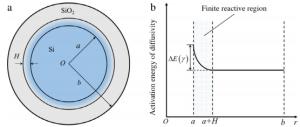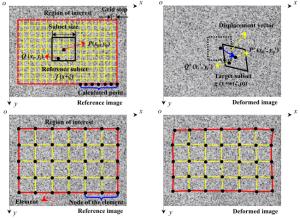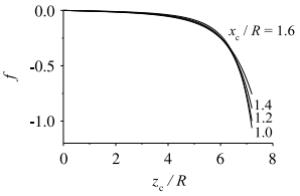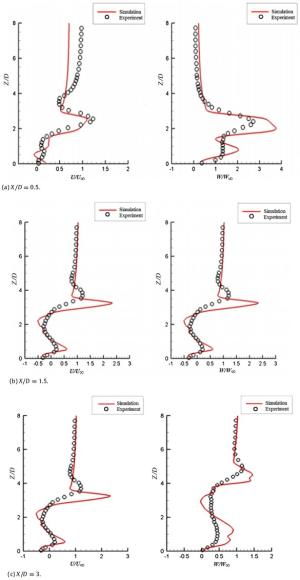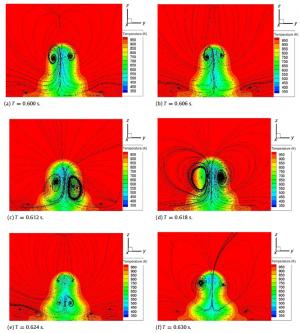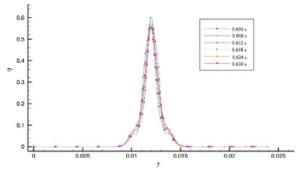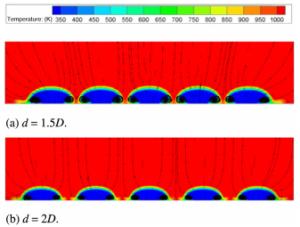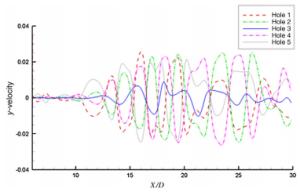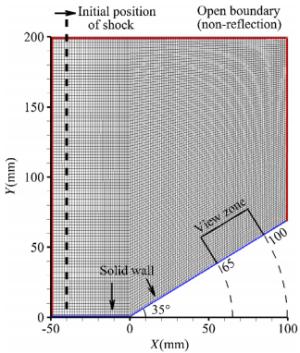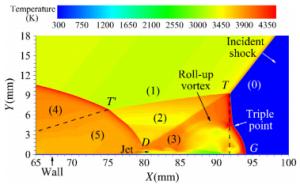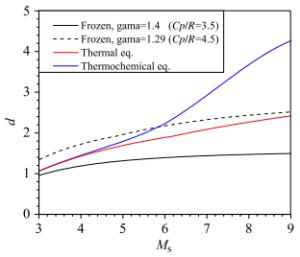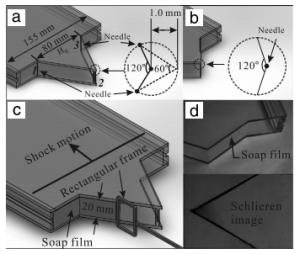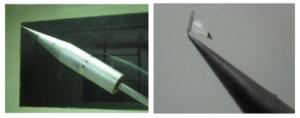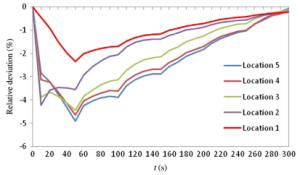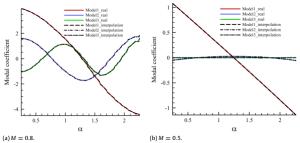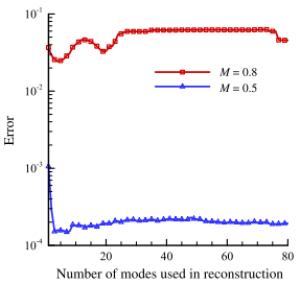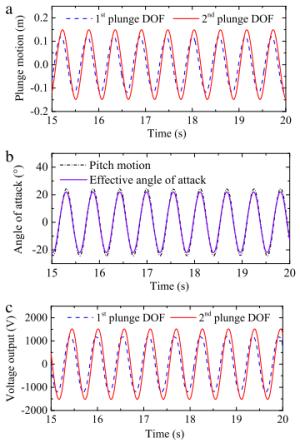Institute of Mechanics,
Chinese Academy of Sciences
2016 Vol.6(5)
Display Mode: |
Theoretical and Applied Mechanics Letters 2016, 6(5): 195-199.
doi: 10.1016/j.taml.2016.08.002
Abstract:
Self-limiting oxidation of nanowires has been previously described as a reaction-or diffusion-controlled process. In this letter, the concept of finite reactive region is introduced into a diffusion-controlled model, based upon which a two-dimensional cylindrical kinetics model is developed for the oxidation of silicon nanowires and is extended for tungsten. In the model, diffusivity is affected by the expansive oxidation reaction induced stress. The dependency of the oxidation upon curvature and temperature is modeled. Good agreement between the model predictions and available experimental data is obtained. The developed model serves to quantify the oxidation in two-dimensional nanostructures and is expected to facilitate their fabrication via thermal oxidation techniques.
Self-limiting oxidation of nanowires has been previously described as a reaction-or diffusion-controlled process. In this letter, the concept of finite reactive region is introduced into a diffusion-controlled model, based upon which a two-dimensional cylindrical kinetics model is developed for the oxidation of silicon nanowires and is extended for tungsten. In the model, diffusivity is affected by the expansive oxidation reaction induced stress. The dependency of the oxidation upon curvature and temperature is modeled. Good agreement between the model predictions and available experimental data is obtained. The developed model serves to quantify the oxidation in two-dimensional nanostructures and is expected to facilitate their fabrication via thermal oxidation techniques.
Theoretical and Applied Mechanics Letters 2016, 6(5): 200-208.
doi: 10.1016/j.taml.2016.08.003
Abstract:
Being the two primary approaches for full-field kinematics measurements, both subset-based local digital image correlation (DIC) and finite element-based global DIC have been extensively studied. Nowadays, most commercial DIC systems employ local DIC algorithm because of its advantages of straight forward principle and higher efficiency. However, several researchers argue that global DIC can provide better displacement results due to the displacement continuity constraint among adjacent elements. As such, thoroughly examining the performance of these two different DIC methods seems to be highly necessary. Here, the random errors associated with local DIC and two global DIC methods are theoretically analyzed at first. Subsequently, based on the same algorithmic details and parameters during analyses of numerical and real experiments, the performance of the different DIC approaches is fairly compared. Theoretical and experimental results reveal that local DIC outperforms its global counterpart in terms of both displacement results and computational efficiency when element (subset) size is no less than 11 pixels.
Being the two primary approaches for full-field kinematics measurements, both subset-based local digital image correlation (DIC) and finite element-based global DIC have been extensively studied. Nowadays, most commercial DIC systems employ local DIC algorithm because of its advantages of straight forward principle and higher efficiency. However, several researchers argue that global DIC can provide better displacement results due to the displacement continuity constraint among adjacent elements. As such, thoroughly examining the performance of these two different DIC methods seems to be highly necessary. Here, the random errors associated with local DIC and two global DIC methods are theoretically analyzed at first. Subsequently, based on the same algorithmic details and parameters during analyses of numerical and real experiments, the performance of the different DIC approaches is fairly compared. Theoretical and experimental results reveal that local DIC outperforms its global counterpart in terms of both displacement results and computational efficiency when element (subset) size is no less than 11 pixels.
Theoretical and Applied Mechanics Letters 2016, 6(5): 209-212.
doi: 10.1016/j.taml.2016.08.010
Abstract:
Based on the Ampere molecular current hypothesis and the Biot-Savart law, a magnetic model on the metal magnetic memory (MMM) testing of a specimen is proposed. Relation between magnetic flux leakage (MFL) and magnetization of a ferro-medium circular cylinder is set up. We can predict magnetization of material according to the MFL on surface of the circular cylinder.
Based on the Ampere molecular current hypothesis and the Biot-Savart law, a magnetic model on the metal magnetic memory (MMM) testing of a specimen is proposed. Relation between magnetic flux leakage (MFL) and magnetization of a ferro-medium circular cylinder is set up. We can predict magnetization of material according to the MFL on surface of the circular cylinder.
Theoretical and Applied Mechanics Letters 2016, 6(5): 213-221.
doi: 10.1016/j.taml.2016.08.007
Abstract:
A large-scale large eddy simulation in high performance personal computer clusters is carried out to present unsteady mixing mechanism of film cooling and the development of films. Simulation cases include a single-hole plate with the inclined angle of 30° and blowing ratio of 0.5, and a single-row plate with hole-spacing of 1.5D and 2D (diameters of the hole). According to the massive simulation results, some new unsteady phenomena of gas films are found. The vortex system is changed in different position with the development of film cooling with the time marching the process of a single-row plate film cooling. Due to the mutual interference effects including mutual exclusion, a certain periodic sloshing and mutual fusion, and the structures of a variety of vortices change between parallel gas films. Macroscopic flow structures and heat transfer behaviors are obtained based on 20 million grids and Reynolds number of 28600.
A large-scale large eddy simulation in high performance personal computer clusters is carried out to present unsteady mixing mechanism of film cooling and the development of films. Simulation cases include a single-hole plate with the inclined angle of 30° and blowing ratio of 0.5, and a single-row plate with hole-spacing of 1.5D and 2D (diameters of the hole). According to the massive simulation results, some new unsteady phenomena of gas films are found. The vortex system is changed in different position with the development of film cooling with the time marching the process of a single-row plate film cooling. Due to the mutual interference effects including mutual exclusion, a certain periodic sloshing and mutual fusion, and the structures of a variety of vortices change between parallel gas films. Macroscopic flow structures and heat transfer behaviors are obtained based on 20 million grids and Reynolds number of 28600.
Theoretical and Applied Mechanics Letters 2016, 6(5): 222-225.
doi: 10.1016/j.taml.2016.08.006
Abstract:
The influence of high temperature effects on the protrusion of Mach stem in strong shock reflection over a wedge was numerically investigated. A two-dimensional inviscid solver applies finite volume method and unstructured quadrilateral grids were employed to simulate the flow. Theoretical analysis was also conducted to understand the phenomenon. Both numerical and theoretical results indicate a wall-jet penetrating forward is responsible for the occurrence of Mach stem protrusion. The protrusion degree seems to depend on the thermal energy buffer capacity of the testing gas. Approaches to increase the energy buffer capacity, such as vibrational relaxation, molecular dissociation, and increase of frozen heat capacity, all tend to escalate the protrusion effect.
The influence of high temperature effects on the protrusion of Mach stem in strong shock reflection over a wedge was numerically investigated. A two-dimensional inviscid solver applies finite volume method and unstructured quadrilateral grids were employed to simulate the flow. Theoretical analysis was also conducted to understand the phenomenon. Both numerical and theoretical results indicate a wall-jet penetrating forward is responsible for the occurrence of Mach stem protrusion. The protrusion degree seems to depend on the thermal energy buffer capacity of the testing gas. Approaches to increase the energy buffer capacity, such as vibrational relaxation, molecular dissociation, and increase of frozen heat capacity, all tend to escalate the protrusion effect.
Theoretical and Applied Mechanics Letters 2016, 6(5): 226-229.
doi: 10.1016/j.taml.2016.06.002
Abstract:
The Richtmyer-Meshkov instability of a ‘V’ shaped air/helium gaseous interface subjected to a weak shock wave is experimentally studied. A soap film technique is adopted to create a ‘V’ shaped interface with accurate initial conditions. Five kinds of ‘V’ shaped interfaces with different vertex angles are formed to highlight the effects of initial conditions on the flow characteristics. The results show that a spike is generated after the shock impact, and grows constantly with time. As the vertex angle increases, vortices generated on the interface become less noticeable, and the spike develops less pronouncedly. The linear growth rate of interface width after compression phase is estimated by a linear model and a revised linear model, and the latter is proven to be more effective for the interface with high initial amplitudes. The linear growth rate of interface width is, for the first time in a heavy/light interface configuration, found to be a non-monotonous function of the initial perturbation amplitude-wavelength ratio.
The Richtmyer-Meshkov instability of a ‘V’ shaped air/helium gaseous interface subjected to a weak shock wave is experimentally studied. A soap film technique is adopted to create a ‘V’ shaped interface with accurate initial conditions. Five kinds of ‘V’ shaped interfaces with different vertex angles are formed to highlight the effects of initial conditions on the flow characteristics. The results show that a spike is generated after the shock impact, and grows constantly with time. As the vertex angle increases, vortices generated on the interface become less noticeable, and the spike develops less pronouncedly. The linear growth rate of interface width after compression phase is estimated by a linear model and a revised linear model, and the latter is proven to be more effective for the interface with high initial amplitudes. The linear growth rate of interface width is, for the first time in a heavy/light interface configuration, found to be a non-monotonous function of the initial perturbation amplitude-wavelength ratio.
Theoretical and Applied Mechanics Letters 2016, 6(5): 230-232.
doi: 10.1016/j.taml.2016.08.004
Abstract:
Strong asymmetrical vortices appear on the leeward of slender body at high angles of attack, which has very unfavorable effect on the stability and control of the aircraft. A method is developed to control the side force of slender body at high angles of attack, and is verified in wind tunnel. A thin-film triangular self-excited oscillation flag is fixed at the tip of the slender body model whose semi-apex angle is 10°. Side force is approximately linearly proportional to roll-setting angle of self-excited oscillation flag at high angles of attack, and the slop of fitting straight line obtained by the least square method is -0.158. The linear relationship between side force and roll-setting angle provides convenience for developing side force control law of slender body at high angles of attack. Experimental data shows that the side force coefficients vary linearly with roll-setting angles when a specific plastic self-excited oscillation flag is used as the control flag. The range of side force coefficient and roll-setting angle are, respectively, -3.2 to 3.0 and -20° to 20°. The device is simple, effective, and is of great potential in engineering application.
Strong asymmetrical vortices appear on the leeward of slender body at high angles of attack, which has very unfavorable effect on the stability and control of the aircraft. A method is developed to control the side force of slender body at high angles of attack, and is verified in wind tunnel. A thin-film triangular self-excited oscillation flag is fixed at the tip of the slender body model whose semi-apex angle is 10°. Side force is approximately linearly proportional to roll-setting angle of self-excited oscillation flag at high angles of attack, and the slop of fitting straight line obtained by the least square method is -0.158. The linear relationship between side force and roll-setting angle provides convenience for developing side force control law of slender body at high angles of attack. Experimental data shows that the side force coefficients vary linearly with roll-setting angles when a specific plastic self-excited oscillation flag is used as the control flag. The range of side force coefficient and roll-setting angle are, respectively, -3.2 to 3.0 and -20° to 20°. The device is simple, effective, and is of great potential in engineering application.
Theoretical and Applied Mechanics Letters 2016, 6(5): 233-235.
doi: 10.1016/j.taml.2016.08.005
Abstract:
Concerning the specific demand on solving the long-term conjugate heat transfer (CHT) problem, a new algorithm of the global tightly-coupled transient heat transfer based on the quasi-steady flow field is further put forward. Compared to the traditional loosely-coupled algorithm, the computational efficiency is further improved with the greatly reduced update frequency of the flow field, and moreover the update step of the flow field can be reasonably determined by using the engineering empirical formula of the Nusselt number based on the changes of the inlet and outlet boundary conditions. Taking a duct heated by inner forced air flow heating process as an example, the comparing results to the tightly-coupled transient calculation by Fluent software shows that the new algorithm can significantly improve the computational efficiency with a reasonable accuracy on the transient temperature distribution, such as the computing time is reduced to 22.8% and 40% while the duct wall temperature deviation are 7% and 5% respectively using two flow update time step of 100 s and 50 s on the variable inlet-flow rate conditions.
Concerning the specific demand on solving the long-term conjugate heat transfer (CHT) problem, a new algorithm of the global tightly-coupled transient heat transfer based on the quasi-steady flow field is further put forward. Compared to the traditional loosely-coupled algorithm, the computational efficiency is further improved with the greatly reduced update frequency of the flow field, and moreover the update step of the flow field can be reasonably determined by using the engineering empirical formula of the Nusselt number based on the changes of the inlet and outlet boundary conditions. Taking a duct heated by inner forced air flow heating process as an example, the comparing results to the tightly-coupled transient calculation by Fluent software shows that the new algorithm can significantly improve the computational efficiency with a reasonable accuracy on the transient temperature distribution, such as the computing time is reduced to 22.8% and 40% while the duct wall temperature deviation are 7% and 5% respectively using two flow update time step of 100 s and 50 s on the variable inlet-flow rate conditions.
Theoretical and Applied Mechanics Letters 2016, 6(5): 236-243.
doi: 10.1016/j.taml.2016.08.008
Abstract:
In this paper, flow reconstruction accuracy and flow prediction capability of discontinuous transonic flow field by means of proper orthogonal decomposition (POD) method is studied. Although linear superposition of "high frequency waves" in different POD modes can achieve the reconstruction of the shock wave, the smoothness of the solution near the shock wave cannot be guaranteed. The modal coefficients are interpolated or extrapolated and different modal components are superposed to realize the prediction of the flow field beyond the snapshot sets. Results show that compared with the subsonic flow, the transonic flow with shock wave requires more POD modes to reach a comparative reconstruction accuracy. When a shock wave exists, the interpolation prediction ability is acceptable. However, large errors exist in extrapolation, and increasing the number of POD modes cannot effectively improve the prediction accuracy of the flow field.
In this paper, flow reconstruction accuracy and flow prediction capability of discontinuous transonic flow field by means of proper orthogonal decomposition (POD) method is studied. Although linear superposition of "high frequency waves" in different POD modes can achieve the reconstruction of the shock wave, the smoothness of the solution near the shock wave cannot be guaranteed. The modal coefficients are interpolated or extrapolated and different modal components are superposed to realize the prediction of the flow field beyond the snapshot sets. Results show that compared with the subsonic flow, the transonic flow with shock wave requires more POD modes to reach a comparative reconstruction accuracy. When a shock wave exists, the interpolation prediction ability is acceptable. However, large errors exist in extrapolation, and increasing the number of POD modes cannot effectively improve the prediction accuracy of the flow field.
Theoretical and Applied Mechanics Letters 2016, 6(5): 244-247.
doi: 10.1016/j.taml.2016.08.009
Abstract:
In this letter, a piezoaeroelastic energy harvester based on an airfoil with double plunge degrees of freedom is proposed to additionally take advantage of the vibrational energy of the airfoil pitch motion. An analytical model of the proposed energy harvesting system is built and compared with an equivalent model using the well-explored pitch-plunge configuration. The dynamic response and average power output of the harvester are numerically studied as the flow velocity exceeds the cut-in speed (flutter speed). It is found that the harvester with double-plunge configuration generates 4%-10% more power with varying flow velocities while reducing 6% of the cut-in speed than its counterpart.
In this letter, a piezoaeroelastic energy harvester based on an airfoil with double plunge degrees of freedom is proposed to additionally take advantage of the vibrational energy of the airfoil pitch motion. An analytical model of the proposed energy harvesting system is built and compared with an equivalent model using the well-explored pitch-plunge configuration. The dynamic response and average power output of the harvester are numerically studied as the flow velocity exceeds the cut-in speed (flutter speed). It is found that the harvester with double-plunge configuration generates 4%-10% more power with varying flow velocities while reducing 6% of the cut-in speed than its counterpart.
 Submit a Paper
Submit a Paper
 Subscription
Subscription
News
MORE+
Call for Papers
MORE+
- Crossing-Mechanics Driven by Big Data
- Machine learning in the fluid mechanics research of wind energy
- Mechanics of Origami/Kirigami structures and metamaterials
- New insights and perspectives on impact biomechanics for human tissues: from injury prevention, protection to protective equipment
- Environmental Mechanics for Extreme Natural Events



